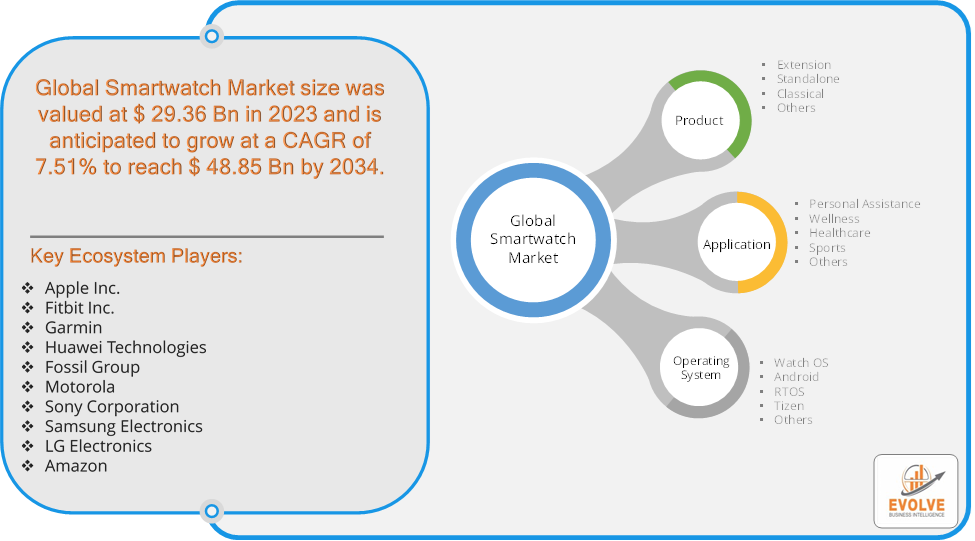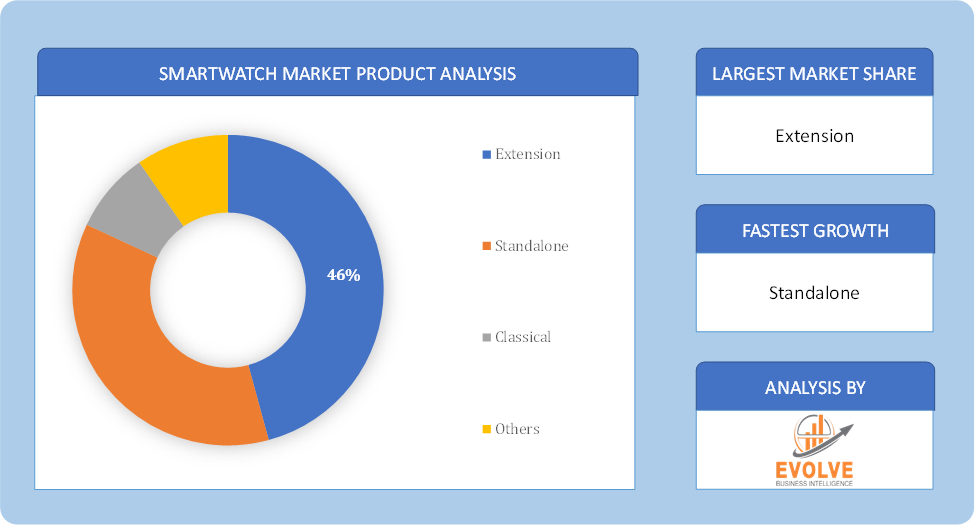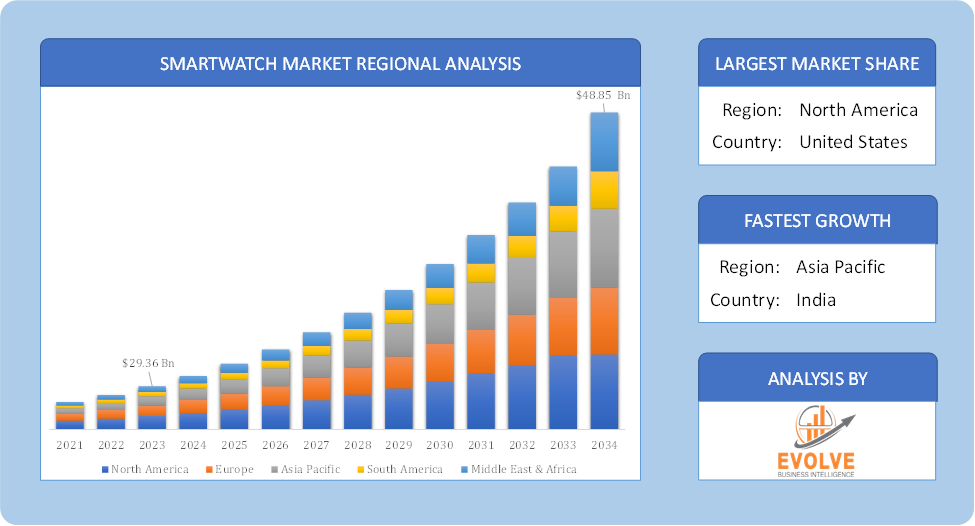Smartwatch Market Overview
The Smartwatch Market size accounted for USD 29.36 Billion in 2023 and is estimated to account for 30.63 Billion in 2024. The Market is expected to reach USD 48.85 Billion by 2034 growing at a compound annual growth rate (CAGR) of 7.51% from 2024 to 2034. The Smartwatch Market refers to the global industry involved in the production, distribution, and sale of smartwatches. Smartwatches are wearable devices that combine the functionality of a traditional watch with advanced features like health monitoring, fitness tracking, GPS navigation, messaging, and the ability to integrate with smartphones and other digital ecosystems. Key features often include heart rate monitoring, step counting, notifications for calls and messages, and compatibility with various apps for wellness, productivity, and entertainment.
The market is characterized by rapid technological advancements and increasing adoption across various demographics and regions. The smartwatch market is driven by factors like increasing health awareness, technological advancements, and changing consumer preferences towards wearable devices.
Global Smartwatch Market Synopsis
 Smartwatch Market Dynamics
Smartwatch Market Dynamics
The major factors that have impacted the growth of Smartwatch Market are as follows:
Drivers:
Ø Technological Advancements
Improvements in battery life, faster processors, better sensors, and the integration of advanced features like GPS, NFC for payments, and cellular connectivity make smartwatches more appealing and versatile for consumers. Wearable tech, including smartwatches, is increasingly seen as a fashionable and functional accessory. The demand for stylish designs with advanced features is driving product innovation and market expansion. Smartwatches offer critical health monitoring for elderly users, making them valuable tools for continuous health tracking, detecting irregular heart rhythms, fall detection, and emergency alerts, which are increasingly relevant as populations age.
Restraint:
- Perception of High Costs and Data Privacy
Premium smartwatches, especially from brands like Apple and Samsung, come with high price tags, making them less accessible to cost-conscious consumers, particularly in developing markets. This limits the potential consumer base, especially in regions with lower disposable incomes. As smartwatches collect sensitive personal health data, users are increasingly concerned about data security and privacy breaches. Fears regarding how data is used, stored, and shared can deter consumers from adopting these devices.
Opportunity:
⮚ Integration of Advanced Health Monitoring Features
There is increasing demand for smartwatches that provide advanced health features, such as blood glucose monitoring, hydration tracking, and mental health management tools. Innovations in these areas can attract health-conscious consumers. Offering customizable designs and features, including interchangeable bands, watch faces, and software applications, can enhance consumer engagement and satisfaction, appealing to a wider range of personal styles and preferences. As smart homes and connected devices become more prevalent, smartwatches can serve as central control devices for managing other IoT gadgets, creating a more integrated user experience.
Smartwatch Market Segment Overview
Based on Product, the market is segmented based on Extension, Standalone, Classical and Others. The Extension segment dominant the market. Access to a wide range of fitness applications for tracking workouts, nutrition, and health metrics. Smartwatches with near-field communication (NFC) capabilities enable users to make contactless payments, enhancing convenience and utility. Ability to receive and respond to messages, calls, and app notifications directly from the watch.
By Application
Based on Application, the market segment has been divided into Personal Assistance, Wellness, Healthcare, Sports and Others. The Healthcare segment dominant the market. Smartwatches have evolved beyond basic fitness tracking and are increasingly being used as valuable tools for healthcare professionals and individuals to monitor and manage various health conditions. Some smartwatches are equipped with medical-grade sensors that provide accurate and reliable health data. These sensors may include ECG (electrocardiogram) sensors, PPG (photoplethysmography) sensors, and more.
By Operating System
Based on Operating System, the market segment has been divided into Watch OS, Android, RTOS, Tizen and Others. The Android segment dominant the market. Wear OS is a version of the Android operating system designed specifically for smartwatches. It is developed by Google and serves as the foundation for various smartwatches from different manufacturers. Smartwatches running Wear OS are typically compatible with Android smartphones, although many of them also offer limited compatibility with iOS devices for basic functions like notifications. Wear OS features a user-friendly interface optimized for the small screens of smartwatches.
Global Smartwatch Market Regional Analysis
Based on region, the global Smartwatch Market has been divided into North America, Europe, Asia-Pacific, the Middle East & Africa, and Latin America. North America is projected to dominate the use of the Smartwatch Market followed by the Asia-Pacific and Europe regions.
 Smartwatch North America Market
Smartwatch North America Market
North America holds a dominant position in the Smartwatch Market. North America, especially the United States, has been a major contributor to the smartwatch market for several years. High adoption rates of wearable technology, with a strong focus on health and fitness features and increased health awareness, technological advancements, and strong brand presence (e.g., Apple, Garmin).
Smartwatch Asia-Pacific Market
The Asia-Pacific region has indeed emerged as the fastest-growing market for the Smartwatch Market industry. The Asia-Pacific region, particularly China and India, is the largest consumer of smartwatches. Low manufacturing costs, a growing middle class, and increasing health consciousness drive demand and rising disposable incomes, growing tech-savvy populations, and the popularity of fitness tracking.
Competitive Landscape
The global Smartwatch Market is highly competitive, with numerous players offering a wide range of software solutions. The competitive landscape is characterized by the presence of established companies, as well as emerging startups and niche players. To increase their market position and attract a wide consumer base, the businesses are employing various strategies, such as product launches, and strategic alliances.
Prominent Players:
- Apple Inc.
- Fitbit Inc.
- Garmin
- Huawei Technologies
- Fossil Group
- Motorola
- Sony Corporation
- Samsung Electronics
- LG Electronics
- Amazon
Key Development
In September 2022, Apple launched the Apple Watch Series 8 and SE by bringing innovative technology and performance, as well as vital safety advancements. Apple Watch Series 8 retains Apple Watch’s popular design, featuring a significant, Always-On Retina display and a robust crack-resistant front crystal.
In August 2022, Fitbit and Google launched two new smartwatches, Versa 4 and Sense 2, which prioritize health and exercise. These devices, powered by the new Fitbit OS, are simple to use and designed to help user with fitness and health tracking.
Scope of the Report
Global Smartwatch Market, by Product
- Extension
- Standalone
- Classical
- Others
Global Smartwatch Market, by Application
- Personal Assistance
- Wellness
- Healthcare
- Sports
- Others
Global Smartwatch Market, by Operating System
- Watch OS
- Android
- RTOS
- Tizen
- Others
Global Smartwatch Market, by Region
- North America
- US
- Canada
- Mexico
- Europe
- UK
- Germany
- France
- Italy
- Spain
- Benelux
- Nordic
- Rest of Europe
- Asia Pacific
- China
- Japan
- South Korea
- Indonesia
- Austalia
- Malaysia
- India
- Rest of Asia Pacific
- South America
- Brazil
- Argentina
- Rest of South America
- Middle East & Africa
- Saudi Arabia
- UAE
- Egypt
- South Africa
- Rest of Middle East & Africa
| Parameters | Indicators |
|---|---|
| Market Size | 2034: USD 48.85 Billion |
| CAGR (2024-2034) | 7.51% |
| Base year | 2022 |
| Forecast Period | 2024-2034 |
| Historical Data | 2021 (2017 to 2020 On Demand) |
| Report Coverage | Revenue Forecast, Competitive Landscape, Growth Factors, and Trends |
| Key Segmentations | Product, Application, Operating System |
| Geographies Covered | North America, Europe, Asia-Pacific, South America, Middle East, Africa |
| Key Vendors | Apple Inc., Fitbit Inc., Garmin, Huawei Technologies, Fossil Group, Motorola, Sony Corporation, Samsung Electronics, LG Electronics and Amazon |
| Key Market Opportunities | · Integration of Advanced Health Monitoring Features · Customization and Personalization |
| Key Market Drivers | · Technological Advancements · Growing Popularity of Wearable Technology |
REPORT CONTENT BRIEF:
- High-level analysis of the current and future Smartwatch Market trends and opportunities
- Detailed analysis of current market drivers, restraining factors, and opportunities in the future
- Smartwatch Market historical market size for the year 2021, and forecast from 2023 to 2033
- Smartwatch Market share analysis at each product level
- Competitor analysis with detailed insight into its product segment, Government & Defense strength, and strategies adopted.
- Identifies key strategies adopted including product launches and developments, mergers and acquisitions, joint ventures, collaborations, and partnerships as well as funding taken and investment done, among others.
- To identify and understand the various factors involved in the global Smartwatch Market affected by the pandemic
- To provide a detailed insight into the major companies operating in the market. The profiling will include the Government & Defense health of the company’s past 2-3 years with segmental and regional revenue breakup, product offering, recent developments, SWOT analysis, and key strategies.








